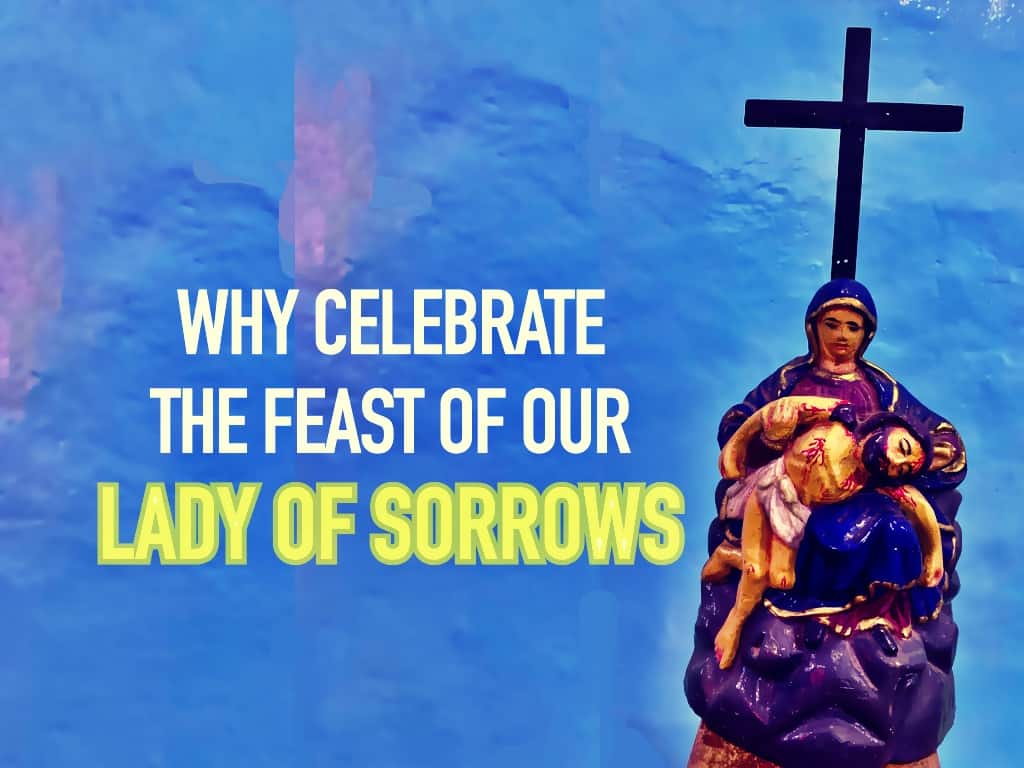
The curious seeker wants to know why we celebrate the feast of Our Lady of Sorrows. The Catholic Church celebrates the feast of Our Lady of Sorrows on September 15, a day after the feast of the exaltation of the Cross to show the close connection between Jesus’ passion and Mary’s sorrows.
The devotion to the seven sorrows of our blessed Mother has roots in Sacred Scripture and Christian piety, associating Blessed Mother with her suffering Son. The Feast of Our Lady of Sorrows is celebrated on September 15. And the feast is like an octave for the Nativity of the Blessed Virgin Mary, which is celebrated on September 8.
The feast was so popular that before Second Vatican Council, there were two feasts devoted to the sorrows of Mary, one on Friday before Palm Sunday and the other in September.
Over a decade ago, I was invited to lead a reflection on our Lady of Sorrows. I planned to focus on joy and wondered why people are so much attached to the feast of our Lady of Sorrows. I learned that people identify with the suffering of Mary, the intensity, compassion, and spiritual martyrdom.
Suffering can lead you to Christ, or faith in Christ can alleviate the pain. I felt that connecting with the suffering, offering consolation, and leading others towards healing is service. And Blessed Mother Mary is an excellent example of overcoming sorrow trusting in God’s plan.
The title: Our Lady of Sorrows
The title Our Lady of Sorrows, given to our Blessed Mother, focuses on her intense suffering and grief during the passion and death of Jesus. The suffering is not limited to the passion and death of Jesus. It comprised of the seven sorrows of Mary. Simeon, the priest in the temple, foretold the pain of Mary in these words – Jesus “is destined to be the downfall and the rise of many in Israel, a sign that will be opposed and you yourself shall be pierced with a sword also that the thoughts of many hearts may be laid bare” (Luke 2:34-35).
The Seven Sorrows of Mary
Because of the seven sorrows, Mary is depicted with her heart exposed and with seven swords piercing it. The seven sorrows of Mary are as follows:
- The Prophecy of the aged Simeon in the temple (Luke 2:25-35)
- The flight into Egypt with the Infant Jesus – 300 miles (Matthew 2:13-15)
- The loss of Jesus in Jerusalem, when He was 12 years old (Luke 2:41-50)
- Mary encounters her Son on His way to Calvary (Luke 23:27-31; Jn. 19:17)
- The Crucifixion of Jesus (John 19:25-30)
- The Body of Jesus from the Cross placed on her lap (Luke. 23: 50 – 54; John 19: 31 – 37)
- His burial (Isaiah 53:8; Luke 23:50-56; John 19:38-42; Mark 15: 40 – 47)
Historical Origins of the Feast
The feast of Our Lady of Sorrows became widespread in the Church during the fourteenth and the fifteenth century. But the feast was popular in the twelfth century under various titles and among the Benedictine monks in the eleventh century.
The feast was placed in the Roman Missal under the title of Our Lady of Compassion in 1482, highlighting the love of Blessed Mother in suffering with her Son, Jesus. In 1668, the feast in honor of the Seven Sorrows (Dolors) was set for the Sunday after September 14, the feast of the exaltation of the Cross. Pope Pius X fixed a permanent date of September 25 for the feast of the Seven Sorrows of Blessed Virgin Mary, now commonly called as the Feast of Our Lady of Sorrows.
The key image of Our Lady of Sorrows
You will notice the Blessed Mother standing faithfully at the foot of the Cross with her dying Son. John records: seeing His Mother at the foot of the Cross and the disciple whom He loved, Jesus said to His Mother, “Woman, here is your son.” And Jesus said to the disciple, “Here is your mother.” (John 19:26-27). Mary kept the divine plan, even in the face of suffering and grieving with her only begotten Son
Is September the month of Our Lady of Sorrows?
September is dedicated to Our Lady of Sorrows. Each month of the liturgical year is devoted to a particular Catholic tradition, usually centered on a feast during that month. August is the Immaculate Heart of Mary; September is the Month of Our Lady of Sorrows. Remember we also celebrate the nativity of the Blessed Virgin Mary on September 8. And the month of October is dedicated to the Most Holy Rosary.
What does Our Lady of Sorrows represent?
The three common artistic representations of a sorrowful Virgin Mary are Mater Dolorosa, Stabat Mater, and Pieta. Our Lady of Seven Sorrows is sometimes represented in sad and anguished mode by herself, her expression being that of tears and sadness.
Mary knows pain because she suffered from Bethlehem to Calvary. Mary, our Mother, understands us as her own children and consoles us in times of trouble. Therefore, we honor Mary as a faithful disciple and exemplar of faith. We unite our suffering to the Lord Jesus, facing them with courage, love, and trust.
About the Author
Feroz Fernandes, a Catholic Missionary, identifies himself as an Uncommon Priest. Father Feroz loves adventure in the apostolate. Check out his debut book The Uncommon Priest: Incredible Stories You Never Read on amazon. And also, the YouTube Channel: Feroz Fernandes promotes a better understanding of scripture.
Leave a Reply